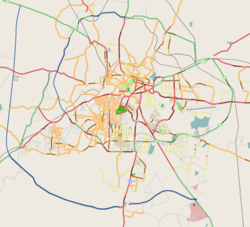| Gavi Gangadhareshwara Temple | |
|---|---|
 A Trident of Lord Shiva outside the Gavi Gangadhareshwara temple at Bengaluru. | |
| Religion | |
| Affiliation | Hinduism |
| District | Bengaluru |
| Deity | Shiva as Gavi Gangadhareshwara |
| Festivals | Maha Shivaratri, Makara Sankranti |
| Location | |
| Location | Gavipuram |
| State | Karnataka |
| Country | India |
| Geographic coordinates | 12°56′53.5″N77°33′46.8″E / 12.948194°N 77.563000°E |
| Architecture | |
| Type | Indian rock-cut architecture |
| Completed | 16th century CE |
Gavi GangadhareshwaraTemple, or Sri Gangaadhareshwara, also Gavipuram Cave Temple, an example of Indian rock-cut architecture, is located in Bengaluru in the state of Karnataka in India. The temple is famous for its mysterious stone discs in the forecourt and the exact planning allowing the sun to shine on the shrine during certain time of the year. It was built in the 16th century by Kempe Gowda I, the founder of the city. [1]











